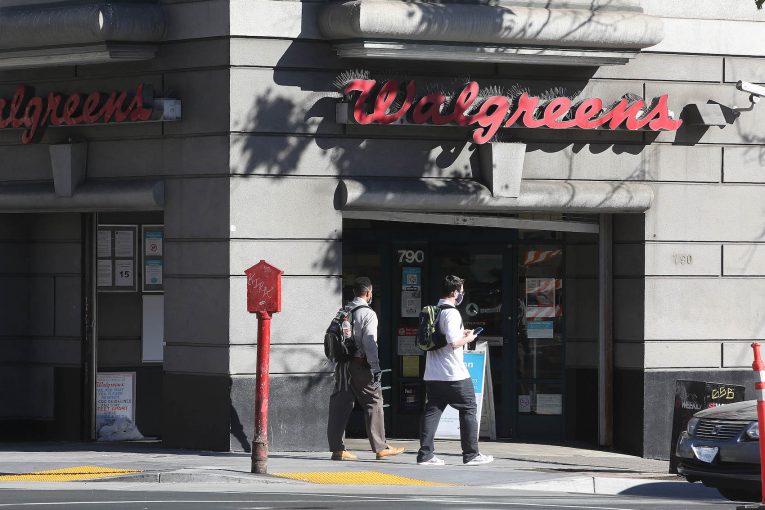

Photo by Lea Suzuki/The San Francisco Chronicle via Getty Images.
By David M. Greenwald
San Francisco, CA -A Chronicle editorial points out that “visceral anecdotes drive crime news and perceptions.” But, as we have pointed out several times over the last month, crime is not going up.
So why are we seeing some retail chains like Walgreens closing their stores while others, Target, are reducing their hours?
I think the story in “Here Say” by Annie Gaus is extraordinarily telling. She tells the story of 49-year-old Rafael Gutierrez, a security guard at Target in downtown San Francisco.
He described a flow of shoplifters who came in multiple times per day to take items. Security guards, he explained, were actually discouraged from intervening. These were under penalty of termination.
He described a frightening encounter where “a woman became so agitated that she smashed wine bottles on the floor and grabbed an elderly man’s cane, nearly knocking him to the ground.
“Everyone’s scared, customers are scared,” he told the publication. “My supervisor called [police] on her. The police didn’t come until an hour later, and they didn’t get a report.”
The actual problem here is that the shoplifters know the score—they know that Target and other chains are not going to attempt to stop them, and that the police will arrive late if they arrive at all.
Gutierrez said that they would “typically only call the police if the person became disruptive or violent, but that slow response times meant that the responding officers often weren’t much help.
“If [Target] really cared about us, they would hire armed security,” he said.
Gutierrez ended up submitting his resignation after working at the store for all of 52 days. Target did not respond to requests for comment from Gaus.
Gaus also talked to CVS—their representative laid the problem on professional shoplifters.
“We’re talking about professional shoplifters that steal, sometimes, up to $10,000 a day from downtown San Francisco stores and sell that through a network of criminal organizations,” said Ben Dugan, director of organized retail crime at CVS.
“We saw what happened at Neiman Marcus on Monday,” Supervisor Ahsha Safai said, referring to a viral video of thieves bolting out of the Union Square store with luxury handbags. “I have personally witnessed people going in to drugstores with bags and emptying shelves. That is what is increasing.”
The data show that the problem is not that there is a crime wave, but what the data do show is that professional shoplifters have figured out how to exploit holes in the system in San Francisco.
Data published from the San Francisco Examiner shows that the organized retail theft cases did rise from 25 cases in 2019 to 43 last year. They also found that DA Chesa Boudin was prosecuting those cases at about the same percentage as his predecessor.
The narrative out there seems to be that what is driving this is changes in California’s law on petty theft—Prop. 47. The problem is that most of these cases can easily be charged as either grand theft or burglary. Either one is a felony.
When I exchanged texts with DA Boudin last week, he pointed out that these cases are charged by his office when he gets them, but one problem is that he is not getting them.
The problem he identified is that San Francisco Police only solve about three percent of thefts. The San Francisco Chronicle in the same article showed that, while shoplifting incidents are down overall, the percentage of cases that ended up with a citation or arrest have plummeted from nearly 40 percent in 2018 to just under 15 percent in 2021.
Indeed, PPIC (Public Policy Institute of California) found that San Francisco has the lowest arrest rate of any police department in California.
Based on the data that we have and the account of people like Gutierrez, the problem does not seem to be the district attorney. They seem to be prosecuting the bulk of the large shoplifting cases that they are getting. The problem appears to be that they are not getting a lot of them.
The problem appears to be that most of these thieves do not believe that they will be caught at all. They go into the store in broad daylight, grab what they can, and either walk or shove their way past loss prevention.
Target reduced their hours, but Gutierrez told “Here Say” that “the change in hours did little to stem the problem.
“Changing the times didn’t do anything but affect us and the customers, who are upset about it, and the shoplifters still get what they want every day,” Gutierrez said. “At 9 o’clock, they’re waiting for us to open.”
He argued that the stores should have armed guards. Another answer would be to restructure the exits so people cannot simply run in and run out with merchandise.
One key question that one would have to ask is why San Francisco has a much bigger problem that other locations. Is it store policies? Policing? Or is it simply that all stores have these flaws, it’s just that San Francisco-area thieves have figured out an easy way to make big cash?
—David M. Greenwald reporting







So the actual theft numbers are a lot higher than what is getting reported. That’s no surprise.